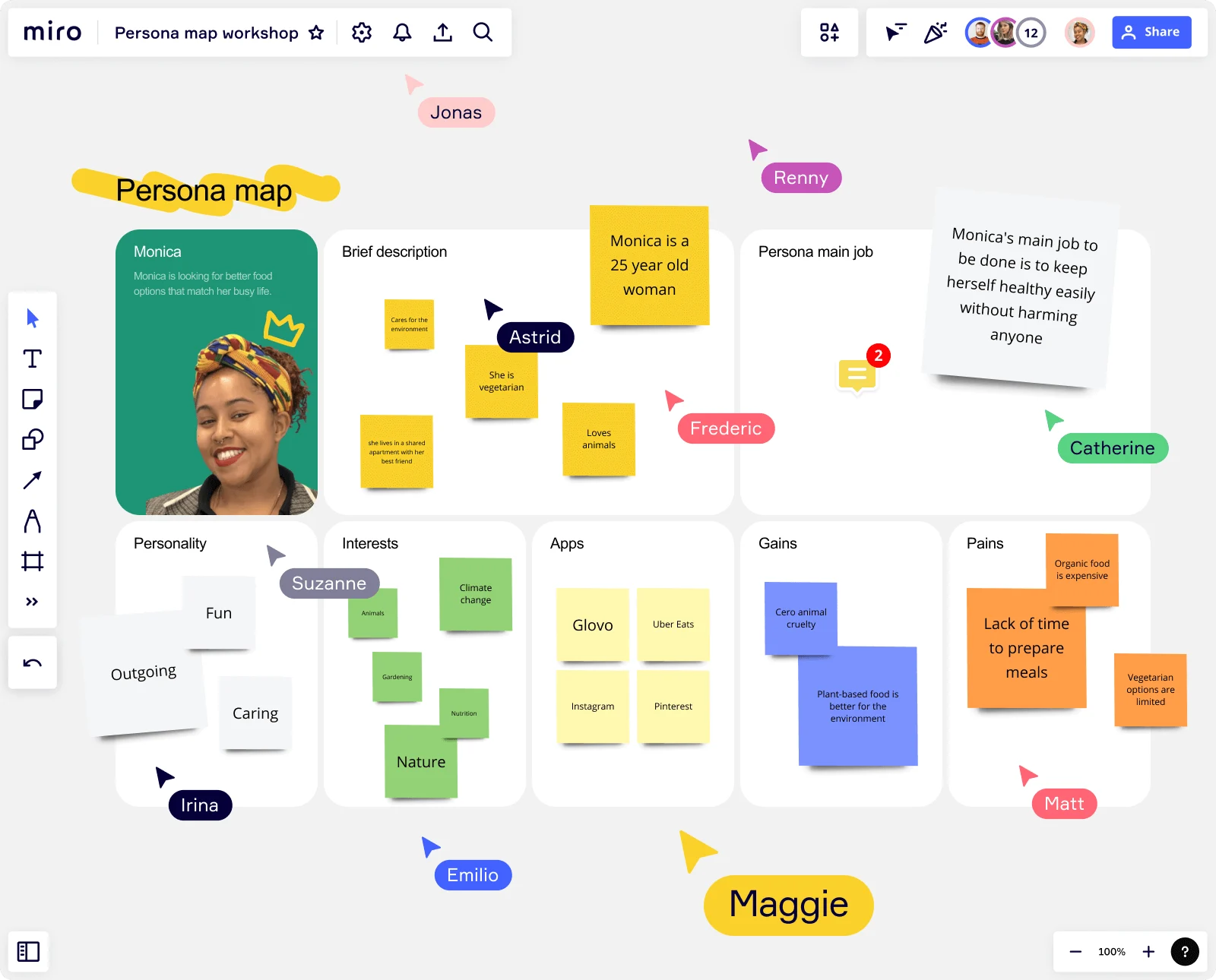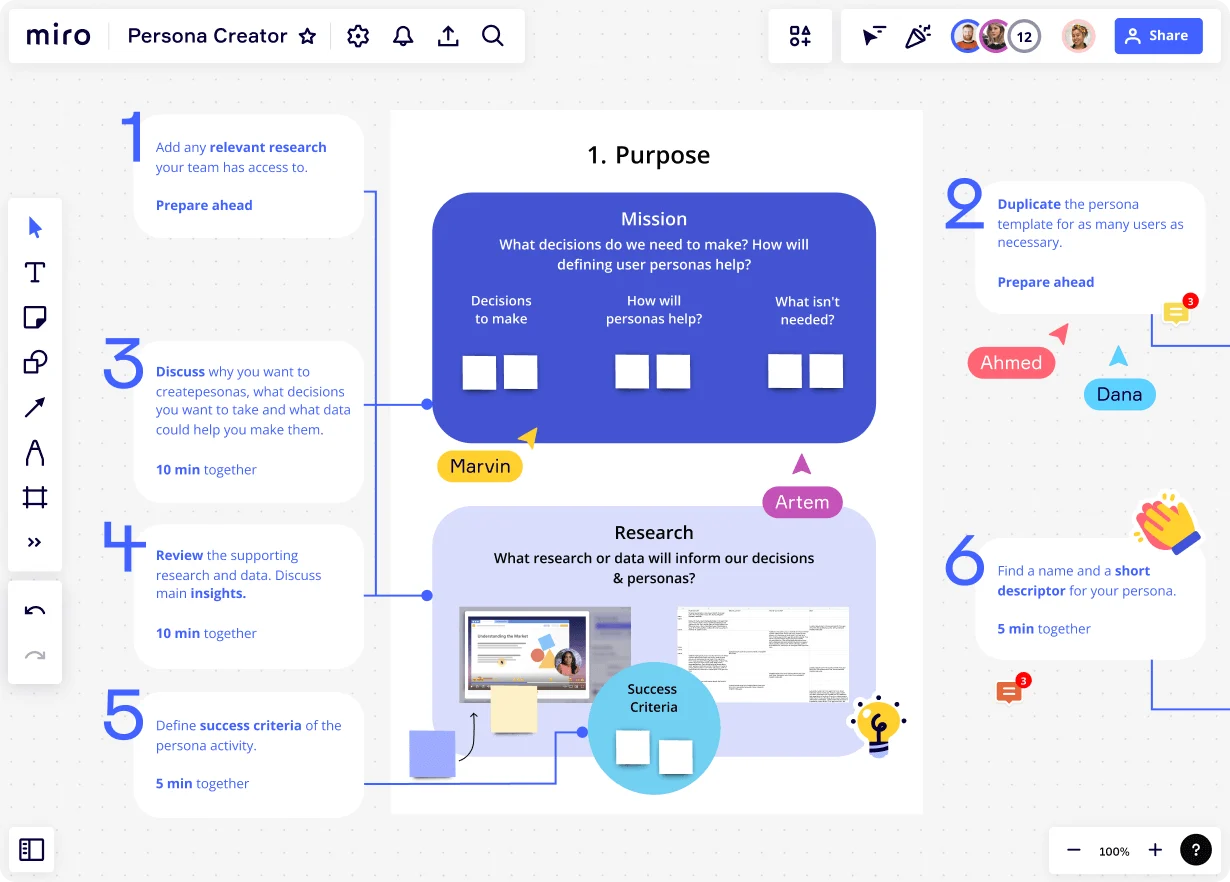
What is a buyer persona?

Summary
In this guide, you will learn:
- What a buyer persona is.
- Buyer personas vs. target audiences.
- How to create buyer personas.
- Buyer personas (decision-makers) vs. customer personas (end-users).
- B2B vs. B2C buyer personas.
- Using buyer persona templates for demographics, goals, challenges, and identifiers.
Try Miro now
Join thousands of teams using Miro to do their best work yet.
Creating effective buyer personas
The buyer persona is one of the most powerful tools for refining who your target audience is and what their needs are. By creating detailed profiles of your ideal customers, you can gain a deeper understanding of their pain points, motivations, and purchasing habits.
In this article, we'll explore how buyer personas can help you connect with your audience, the steps you can take to create personas, and common mistakes to avoid.

What is a buyer persona?
A buyer persona, also known as a customer persona or marketing persona, is a fictional character that embodies the characteristics, preferences, and needs of a specific segment of your target audience. It's a strategic tool that helps humanize your target audience, allowing you to understand them on a deeper level.
This persona archetype provides insights to guide marketing strategies and decision-making. So for example, instead of creating campaigns to address your audience — an abstract concept — you create campaigns that speak to Tyrell, the analytical Creative Director that's struggling with keeping track and reusing the assets that his team creates.
A buyer persona is different from your target audience. A target audience (also called a target market) represents the broader group of potential customers, while a buyer persona represents a more specific subset or segment within that target market. You can create buyer personas by combining market and customer research to provide a deeper understanding of the motivations, behaviors, goals, challenges, and preferences of the individuals within that segment.
What about negative personas?
Negative personas represent individuals who aren't a good fit for your products or services. It's important to consider these personas as well to avoid wasting resources on targeting the wrong audience. Incorporating negative personas into your overall strategy helps you understand who your offerings aren't intended for.
What should a buyer persona include?
A well-developed buyer persona typically includes the following elements:
- Name and picture: What is the persona's name? What do they look like? Giving the persona a fictional name and picture makes them feel more real and relatable.
- Demographics: What are the persona's age, gender, location, occupation, and income level?
- Psychographics: What are their interests, hobbies, values, and lifestyle choices?
- Goals and motivations: What does your persona want to achieve? What drives them to make certain decisions?
- Pain points and challenges: What are the problems, obstacles, and frustrations the persona faces?
- Buying behavior: How does the persona research, evaluate, and make purchasing decisions? What are the factors that influence their choices, such as preferred channels, buying triggers, considerations, and barriers?
- Real quotes: What are your persona's opinions on their desires and needs? How do they perceive the value of your product or service?
By including these elements in a Buyer Persona Template, you can have a structured format to gather, organize, and refer to the necessary information.
It's important to note that the specific elements and level of detail within a buyer persona can vary depending on the nature of your business, industry, and target audience. The goal is to create a comprehensive and accurate representation of your ideal buyers, enabling you to tailor your marketing strategies and offerings to meet their specific needs effectively.
Tips to create a buyer persona
Here's a step-by-step guide on how to build a buyer persona.
Step 1: Research your target audience
When researching your target audience to create a buyer persona, you can use a variety of qualitative and quantitative research methods, analytics tools, and internal resources. By leveraging diverse sources of information, you can build a comprehensive view of your customers and create accurate and effective buyer personas.
Here are the different sources of information you can use and how they can contribute to your buyer persona creation process:
Qualitative research
- Customer interviews: Conduct one-on-one interviews with your existing and potential customers. Utilize user interview templates to ensure consistency in data collection and analysis.
Quantitative research
- Surveys: Create and distribute surveys to a larger audience to gather quantitative data about demographics, preferences, behaviors, and satisfaction levels.
- Industry reports: Refer to industry-specific reports and studies that provide market trends, customer behavior insights, and competitive analysis.
Analytics tools
- Website analytics: Utilize tools like Google Analytics and Google Search Console to analyze website traffic, user behavior, demographics, and engagement metrics.
- Social media analytics: Monitor social media platforms to gain insights into audience demographics, engagement rates, content preferences, and sentiment analysis.
- Customer Relationship Management (CRM): Leverage your CRM system to gather information about customer interactions, purchase history, preferences, and feedback.
- Keyword research tools: Use keyword research tools to identify the search terms and phrases your target customers use to find information related to your products or services.
Customer feedback
- Feedback surveys: Use tools like Hotjar or email to implement feedback surveys after customer interactions, purchases, or website visits to collect insights and gauge satisfaction levels.
- Online reviews and ratings: Analyze online reviews and ratings on platforms like Yelp, Google Reviews, or industry-specific review sites.
Internal resources
- Customer support team: Collaborate with your customer support team to gain insights from their interactions with customers.
- Sales representatives: Engage with your sales team to understand the feedback they receive during the sales process.
There's a lot of data you'll be working with in this phase, which can be overwhelming. A collaborative workspace like Miro can greatly facilitate your research by providing an online platform for your team to collaborate, organize, and visualize research data. You can also explore all persona templates in Miro to kickstart your work and guide your research effectively.
Having a single location for data storage ensures easy access, organization, and retrieval of research findings. This also fosters efficient collaboration, knowledge sharing, and cross-functional input during the research process.
Step 2: Analyze and organize the data
Now it's time for you to make sense of the data you've gathered. Process the information, identify patterns and trends, and categorize it in a way that allows for effective use in persona development.
On Miro, your team can use sticky notes, tagging, and grouping functionalities to organize research data, identify themes, and create meaningful connections between different data points.
Start by looking for recurring patterns and commonalities within the data. Then you can create categories or tags based on the identified patterns. The categories could include shared preferences, needs, motivations, pain points, or demographic characteristics.
Invite team members to add their observations, insights, or questions to the shared Miro board to facilitate a collaborative analysis process. This is an iterative process that ensures the analysis is comprehensive and accurate.
Step 3: Begin building detailed buyer persona profiles
Now it's time to put all of the above together. Start by answering the question: How many buyer personas do I need?
There's no fixed rule on the exact number of personas you should have. Ideally, you should create a separate buyer persona for each distinct segment of your audience that exhibits different behaviors, needs, motivations, and preferences.
Get together with your team and answer the following questions:
- Which user groups should we focus on?
- Which user groups should we not focus on?
- What information is important to include in our persona profiles?
- What information should we not include? Why?
This brainstorming exercise helps you get back to why you are creating your personas. You should consider your business goals and objectives.
As a general rule of thumb, it's best to have more than one persona but not too many, or it'll be confusing. Aim for building 2–5 persona profiles.
You can start with a predefined user persona template which you can populate and adapt to fit your specific needs.

Mistakes to avoid when using buyer personas
When using buyer personas, it's essential to be aware of potential pitfalls and avoid common mistakes that can undermine their effectiveness. Here are some mistakes to avoid:
- Making assumptions: One of the biggest mistakes is relying on assumptions instead of conducting thorough research. Base your personas on real data and insights from customer research and feedback.
- Creating too many personas: While it's important to represent different customer segments, creating too many personas can lead to confusion and dilute your focus.
- Lack of specificity: Avoid creating generic or vague personas that don't provide actionable insights.
- Overemphasizing demographics: While this is the easiest type of data to get access to, focusing solely on demographics can limit the effectiveness of your personas.
- Lack of alignment and communication: Ensure that your personas are communicated and understood across your organization.
- Failing to update or refine your personas regularly: Buyer personas should evolve and reflect changes in your target audience over time. Failing to update and validate your personas with new data and insights can lead to outdated and inaccurate representations of your customers.
- Not acting: Avoid treating personas as mere documents or exercises. Use personas to inform decision-making and drive customer-centric initiatives.
Build your buyer persona with Miro
Buyer personas help you understand and connect with your target audience. By creating detailed profiles of your ideal customers, you can gain a deeper understanding of their pain points, motivations, and purchasing habits.
This, in turn, helps you tailor your marketing messages and campaigns to better resonate with your audience, leading to more effective marketing, improved product development, and more efficient use of resources.
Use Miro's collaboration platform to work together with your team in real-time to gather and analyze data, identify key characteristics, and create detailed buyer personas.
Author: Miro Team
Last update: October 14, 2025